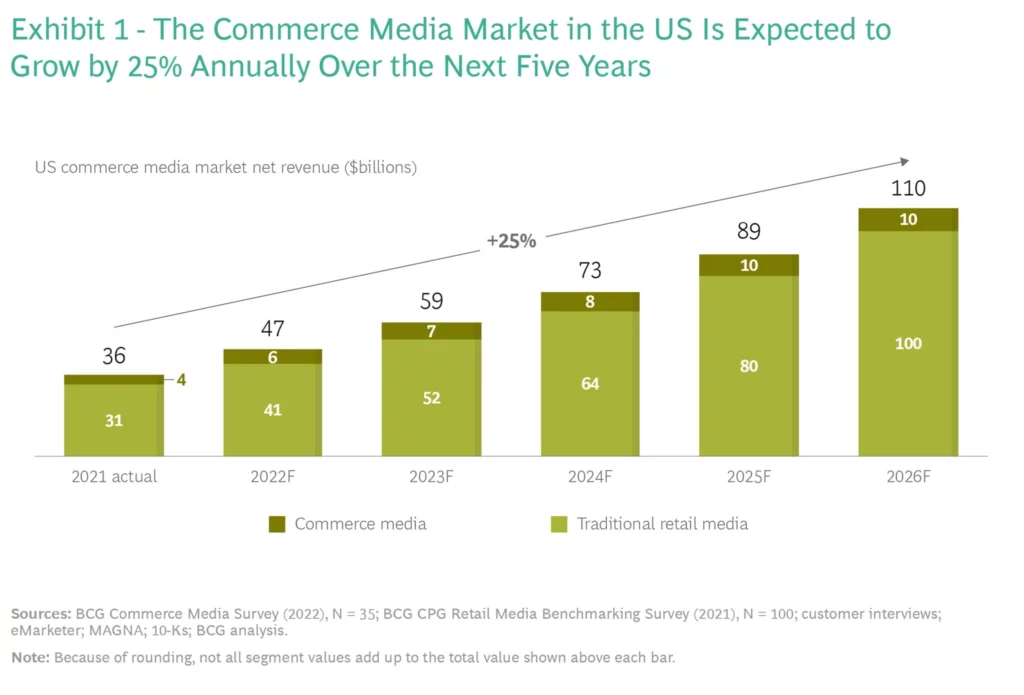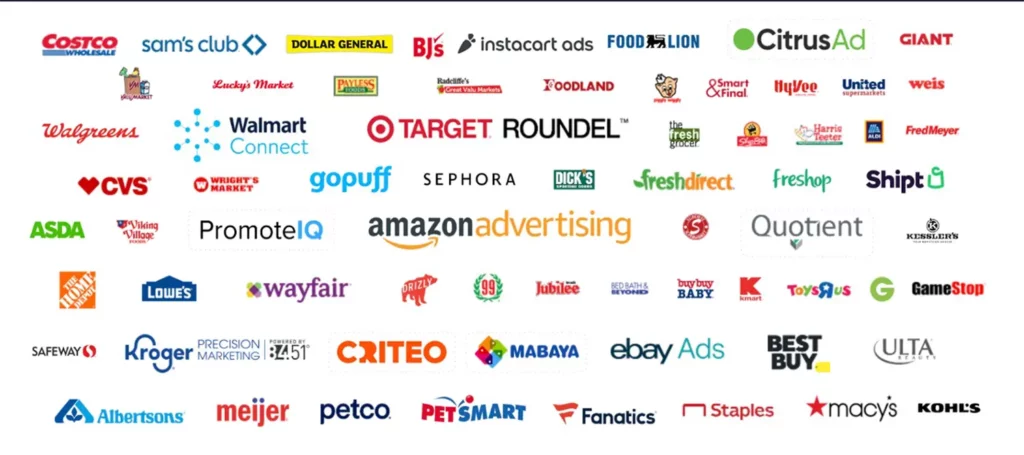Building a Retail Media Network: Your Roadmap to Success

With the retail media landscape changing so fast, it’s a daunting task to throw your hat in the ring and create your own retail media network (RMN). We’re to help.
In this guide, we’ll cover the tech from the basics to the advanced to help you make the best decisions when it comes to building an RMN.
Table of Contents
- The Current State of Retail Media Tech
- Today’s RMN Landscape
- Tech You Need To Get Started
- Pros and Cons of Building In-House vs. Outsourcing
- How Goodway Group Works With Retailers To Build Custom RMNs
The Current State of Retail Media Network Tech
Retail media refers to advertising platforms and channels that are owned and operated by retailers themselves. These platforms allow brands and advertisers to reach customers through targeted advertising while they are shopping online or in-store. It encompasses a variety of advertising formats, including sponsored product listings, display ads and video ads, among others. These ads can appear on a retailer’s website, mobile app, email newsletters and even in physical stores.
Retail media is expected to grow over 10% per year in the next three years, with a $50B estimated increase in spending from 2022 to 2026. This growth isn’t limited to the traditional commerce industry. Retail media’s success is prompting industries like travel and auto to get in on the game. Boston Consulting Group estimates that media revenue from the expanded group of industries that we call “commerce media” could add $10 billion on top of the baseline $100 billion net revenue estimate for retail media in the U.S. over the next five years. These are big numbers, leading to retailers and brands across the world to tap into RMNs to make better use of their first-party data and create a better customer experience.

Source: BCG How Retail Media is Reshaping Retail
Today’s RMN Landscape
We’re all familiar with the big players in the retail media advertising space: Amazon, Target, Walmart and Kroger. If you’ve been following their growth, you’re likely also familiar with the companies helping to build these media networks.
While some retailers choose to build their retail media network entirely in-house — like 7-Eleven did with their Gulp Media Network or how Lowe’s used in-housing retail media efforts in the name of efficiency — most retailers don’t have the infrastructure needed to build an RMN themselves.

Companies like Criteo, CitrusAd and PromoteIQ are a few of the more popular self-service retail network platforms retailers use to buy retail media ads at scale. These platforms support personalized ads that can be targeted to consumers without relying on third-party cookies. They also typically include dashboards for viewing reports and data from your campaigns.
First Things First: What You’ll Need To Get Started
These are the table stakes necessities you’ll need to have a handle on before diving into the RMN-building process.
1. Data Clean Room
Retailers have a vast amount of first-party data stemming from the first customer touchpoint. This data allows for better targeting, and well-targeted ads enhance the overall user experience on your site, which means more conversions, better customer loyalty and ultimately, more shopper touchpoints (meaning even more first-party data).
Make sure you have a data clean room solution in place to prepare for when cookies go away. Data clean rooms allow for better usage of your existing first-party data as well as the additional first-party data that will be generated by your media network.
2. Cross-Channel Reporting
Ensure you have a solution in place to tie things together across different channels and different partners. How will you fold in different demand-side platforms (DSPs) and do cross-vendor attribution and reporting? Some DSPs make this challenging. For example, Meta and Google both have clean rooms that they may push you to use, but it’s difficult to have cross-channel reporting with either option due to the restrictions both companies put on their data sharing and use.
3. True Identity Resolution
The best RMNs start with the best data. It’s important to choose a partner that will help you make the most of your first-party data so you can track an individual’s complete buyer journey. This data will inform how you interact with each individual shopper and the actions those shoppers take. Those initial interactions will then inform how the shopper next interacts with your brand, building a continuous loop of information.
Leveling Up Your Retail Media Tech
Ready to go beyond the basics and build an RMN that rivals that of your competitors, offering chances for increased revenue and more precise measurement? Here are some things to consider.
Should You Build In-House or Outsource?
When deciding whether to build your RMN in-house or outsource, keep in mind that building an RMN yourself involves a substantial monetary investment. As a retailer, you would need to make significant hires in analytics, engineering, operations, creative, technology and media before you could even get the project off the ground. Unless you are a major retailer with the budget to match, this may not be the best route.
So, if you want to launch an RMN without incurring major upfront costs, you may want to outsource. The benefit of outsourcing is that you can vet and pick a partner who has both a knowledgeable staff and experience launching RMNs.
Choosing the Right Partner if You’ve Decided to Outsource
A good retail media partner will be able to handle the process of strategy, media planning and buying, measurement and reporting. Most importantly, they will have a solid understanding of how individual retail media platforms operate and be able to connect the dots between them.
Multiple Tech/Data Partners Versus a Single Platform
Working with a single platform turnkey solution means you won’t be able to go as deep into measurements and results as you could in any individual platform. You’d likely only get canned reports that wouldn’t offer as much flexibility when it comes to doing complex analyses. This would make it difficult to not only understand the full effect of your campaigns but would also mean limited insights into the impact on the customer experience, too.
However, if you use multiple vendors and can go directly into a platform, you’ll have the ability to write log-level queries. This gives you much better data visibility and more flexibility to be able to do whatever you want with the data directly from the vendors.
There is a downside, though — when using multiple vendors, it can be hard to make connections in a meaningful way. Disparate systems also don’t always play well together, making planning and executing a campaign very complex. Plus, you’d have different reps at each vendor and would likely have to do a lot of repetitive tasks.
There Is Another Option
We’re starting to see more consolidation of media solutions providers, which means retailers can get all the things they want from different partners with the convenience of one solution connected to multiple partners. Who offers this kind of partnership? Meet Goodway Group.
Goodway works with multiple tech/data partners as a managed service partner to keep things streamlined for you. You get all the benefits of working with multiple partners without any of the drawbacks. We help make the connections, deal with the different platforms and vendors and tie everything together to tell a story.
How Does Goodway Work With Retailers To Launch an RMN?
Here’s an overview of what working with Goodway to build a retail media network looks like.
1. Initial Consulting Period
Goodway consults with the retailer to figure out key goals and better understand what the retailer wants to accomplish with their RMN. This will help us determine the best product mix and the best approach to measurement.
2. Technical Consulting
During this phase, we’ll help you understand the limitations and/or advantages of the tech you already have, what tech you’ll need for your RMN and how to approach your data. We’ll also start looking into what tools, vendors and platforms to use during the building process. For example, what identity resolution product will you use? What are your best choices for a CRM platform, clean room or media delivery platform?
3. Reporting Needs Assessment
We’ll work with you to figure out what reporting you need and what you care about. Standard industry measurement points such as ROAS, multi-touch attribution and incrementality will be incorporated.
If you’re using a clean room, Goodway will help to tie the data together and connect all the pieces.
4. Build Period
This is where engineering, data science and analytics work is completed based on the consultations and assessments above. We’ll:
- Go through audience taxonomy.
- Connect tech, data and media sources.
- Finalize ad offerings.
- QA everything.
5. Onboarding Period
Goodway helps define a rollout strategy for you to align with best practices. You can expect a beta testing period with a handful of advertisers to ensure that everything is operating as expected. Here is also where we do proof of concept testing and finalize reporting dashboards.
6. Launch Period
During the launch period, we’ll have vendor planning sessions, work on forecasting/media plan development, activate media, execute billing, and go over measurement and analytics. We’ll continue to QA to make sure everything is operating as expected.
7. Refine & Evolve
Once your RMN is up and running, we’ll continue to work together to prioritize improvements, expand your advertiser base and build version 2.0 and 3.0 roadmaps.
Why Use Goodway To Help Build Your RMN?
Here are some reasons to consider partnering with Goodway for your RMN build.
Custom Analytics & Reporting
Our analytics team is here to support you in every step of your RMN journey. From measuring incrementality to doing brand/category analyses and recommending audiences based on previous purchase history and demographics, we can help make the most of your first-party data.
We can also do cross-channel lift studies, utilize market basket analytics tools, provide custom reporting solutions and tailored strategy deployment on a per-advertiser basis, and even create a bespoke attribution model to see how media is performing.
Dedicated Engineers
Our engineering team creates custom-built solutions to help accurately and efficiently scale with even the largest of retailers. They also use proprietary tech solutions to help with campaign setup, billing and QA to ensure accuracy for your advertisers. We rely on advanced tools and innovative techniques to maximize advertising results for our clients and partners.
Custom Account Team
Goodway Group has 15+ years of experience as a service partner and can provide implementation, planning, buying and campaign execution services.
Through a dedicated support team, with team members across various disciplines, Goodway Group provides expertise in account management, media planning and strategy and media execution — including ad operations and buying, as well as reporting. No two job support teams look alike because we build custom teams to support each of our partners based on their overall needs and goals.
Let’s Talk!
Whichever option you choose — building in-house or choosing an outside partner — it’s crucial to make sure the infrastructure and expertise are there to support future growth.
As the retail media landscape becomes more crowded and complex, having a partner like Goodway Group can help you not just catch up with your competitors, but get ahead of them. Contact us today to get a free consultation for your RMN building goals.





